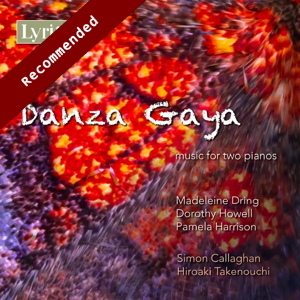
Danza Gaya – Music for Two Pianos
Simon Callaghan, Hiroaki Takenouchi (pianos)
rec. 2023, Wyastone Leys, Monmouth, UK
Lyrita SRCD433 [74]
Leah Broad’s booklet notes point out several commonalities among the composers recorded here. To summarize, Madeleine Dring, Dorothy Howell and Pamela Harrison were active at about the same time, wrote tonally, and composed concert music and lighter pieces – the latter are what is mostly featured here. Howell is one of the protagonists of Broad’s book Quartet: How Four Women Changed the Musical World, Faber & Faber 2023. Both she and Harrison are discussed in this article.
Pamela Harrison’s Dance Little Lady was written for a friend who had taken up the piano rather late in life. The best of the six pieces are the scherzo and the rather Holstian lento. The set fits this disc’s brief, but those interested in her larger works might look at her chamber and vocal music.
Dorothy Howell’s four work here cover a range of styles. The Mazurka is an enjoyable teaching piece. Spindrift, perhaps her best-known work, used to be a popular concert number in its solo version. To describe it as a whirlwind of sound is to not do it justice. The two Recuerdos preciosos (Precious Memories) live up to their name; they strike more deeply than the Mazurka and Spindrift. They derive from a trip Howell took to Barcelona in the mid-1930s. The colorful second piece is inspired by a Sunday afternoon at the city’s main amusement park. More serious is the first, descriptive of a walk in the Cathedral of Barcelona. There is a slight similarity here to the music of Turina, but the harmonic element is Howell’s own. Her sincerity of emotion is not only worthy of the many other composers who have written “cathedral” pieces.
Madeleine Dring’s takes up about two-thirds of the programme. She is also better represented on disc. The four “geographical” pieces that come first were not written as a set, but they are a good overview of her lighter but distinctive style. Three for Two and the Four Duets are teaching pieces. They show that Dring had no difficulty injecting variety and interest into her works for this type of repertoire. More substantial is the clever Tarantelle, reminiscent of the film music of the late 1940s; she too wrote music for radio and television, as well as a good deal of incidental music, including for a 1945 play Apple-Pie Order. She revised the latter and published as Three Fantastic Variations on “Lilliburlero”. The variations are imaginative, with real sadness in the second and a lot of humor in the third. The pieces could have made a good short orchestral work if Dring had been inclined to orchestrate it.
The Sonata for Two Pianos was not well received at its premiere in 1951, I cannot see why. This is a major work for the medium with a striking, almost sinister opening movement, contrasted with a wistful central one and a stirring close in the final allegro vigoroso. It is hard to believe that this is the first recording.
Simon Callaghan and Hiroaki Takenouchi have recorded much repertoire for two pianos. Especially interesting is a recording of Saint-Saëns’s arrangements of Chopin’s and Liszt’s piano sonatas (review). They bring the same insight and clarity to this music. Delightful from start to finish.
William Kreindler
Previous review: Nick Barnard (March2024)
Buying this recording via a link below generates revenue for MWI, which helps the site remain free.



Contents
Madeleine Dring (1923-1977)
Danza Gaya (1964)
Valse française (publ. 1980)
Italian Dance (1960)
Caribbean Dance (1959)
Dorothy Howell (1898-1992)
Recuerdos preciosos I & II (1934?)
Pamela Harrison (1915-1990)
Dance Little Lady (1976)
Madeleine Dring
Sonata for Two Pianos (1951)
Three for Two (publ. 1970)
Tarantelle (1948)
Four Duets (publ. 1964)
Dorothy Howell
Mazurka (1937?)
Spindrift (1920)
Madeleine Dring
Three Fantastic Variations on ‘Lilliburlero (1948)

















